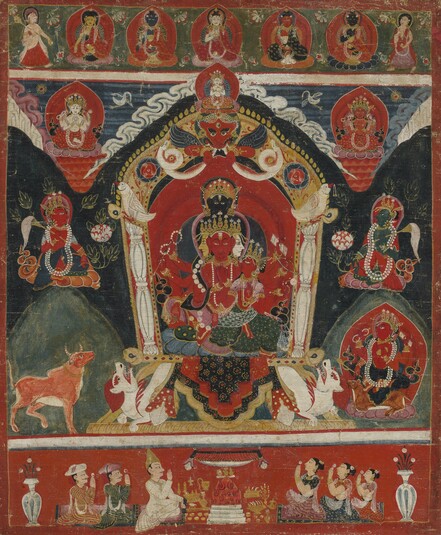
Item: Manjushri (Bodhisattva & Buddhist Deity) - Maharagavajra
| Origin Location | Nepal |
|---|---|
| Lineages | Buddhist |
| Material | Ground Mineral Pigment on Cotton |
| Collection | Private |
Classification: Deity
Maharagavajra Manjushri with Consort or Dharmadhatu Vagishvara Manjushri and Consort. (See an almost identical painting and a similar painting from the Jucker Collection). The identification of the central figure of this painting is based entirely on the publication Kathmandu Valley Painting. The Jucker Collection. Hugo E. Kreijger. Photography by Mischa E. Jucker. Shambhala Publications: Boston, 1999. #26, pages 78 and 79.
'Maharagavajra' is a Sanskrit epithet meaning great 'maha' desire 'raga' and the final use of 'vajra' which implies clearly that the epithet is intended for a Buddhist figure associated with Vajrayana, or in other words related to, or originating in, the Tantric literature of Buddhism.
The central figure of the painting is far more similar in appearance to forms Dharmadhatu Vagishvara Manjushri or off Lokeshvara, and Hala Hala Lokeshvara in particular. However, the colour of the body is different, and the number of heads and arms are different. It is also worth noting that there is no Maharagavajra in the published Nepalese list of the 108 Forms of Avalokiteshvara (The Indian Buddhist Iconography. Benoytosh Bhattacharyya, 1958).
A positive identification for the central figure and consort can only happen after a Sanskrit, Nepalese, Newari or Tibetan language text is found that identifies and describes the deity and consort.
(From an edited version of the Bari Gyatsa of Bari Lotsawa Rinchen Drag). [#19] Hala Hala Lokeshvara: "...Lord of the World Hala Hala, with three faces and six hands. The body and main face are white, the right blue, the left yellow and each has three eyes. With six hands, the three right hold, [the gesture of] supreme generosity, a bead garland and an arrow; the three left, touching the breast of a goddess of [the] desire [realm] sitting upon the knee, a white lotus stem with three branches and a bow. With a skull garland and half moon as a crown. Wearing jewel ornaments and a tiger skin as a lower garment. Seated in a precious cave in the lalitasana [posture]. At the right side is a snake coiled around a trident. At the left, resting above a lotus is a flower filled skullcup."
The central figure is peaceful in appearance, male, red in colour, with five and eight arms. The central face is red, right yellow, left white and upper face blue. The main pair of hands in the teaching gesture at the heart. the second pair hold a vase and a flower blossom. the third pair hold an arrow and bow.the final pair hold a prayer bead 'mala' and a book. He is seated in a relaxed posture with the proper right leg slightly forward. The consort, red in colour, with one face and two hands . Both hands perform gestures. They are seated on a lion supported throne with a decorative throne back 'torana' behind.
In the top register are the Five Tantric Buddhas of the Five Families along with a single attendant figure standing to the far right and left.
At the bottom center is a fire pit and shrine with a Vajracharya priest performing a fire ritual. on the left side are the male donors of the ritual and seated on the right side are the females.
Jeff Watt 1-2014
Subject: Five Buddhas (Secondary Figures)
Buddhist Deity: Manjushri, Rare & Unusual Forms
Buddhist Deity: Manjushri, Maharagavajra

